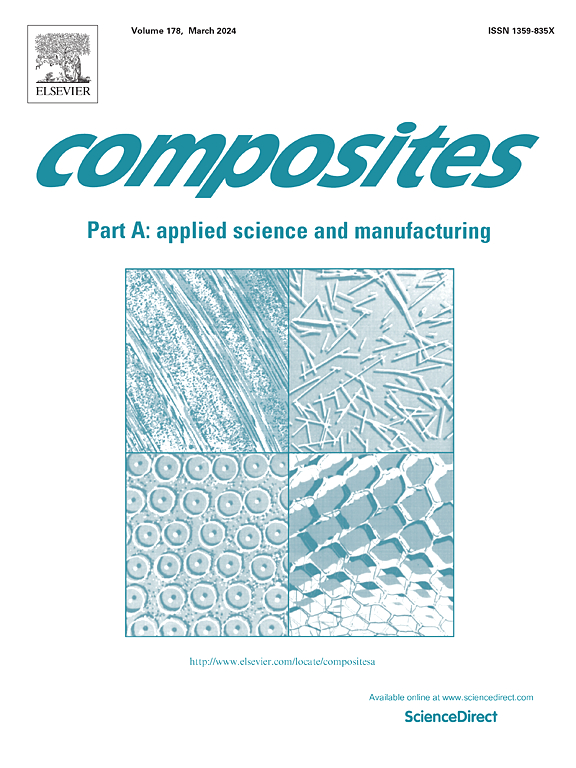通过混合 CVI 和 PIP 方法制备的 SiCf/SiC 复合材料的超高室温和高温机械性能:PIP 温度的影响
IF 8.1
2区 材料科学
Q1 ENGINEERING, MANUFACTURING
Composites Part A: Applied Science and Manufacturing
Pub Date : 2024-10-17
DOI:10.1016/j.compositesa.2024.108502
引用次数: 0
摘要
采用化学气相浸润(CVI)-聚合物浸润和热解(PIP)混合工艺,在 1100 ℃(1100PIP)、1300 ℃(1300PIP)和 1500 ℃(1500PIP)的不同 PIP 温度下制备了单向(UD)SiCf/SiC 复合材料。研究了 PIP 温度对各组分微观结构的影响。结果表明,SiC 纤维强度和界面剪切强度(IFSS)是影响复合材料机械性能的主要因素。1100 °C时,纤维热稳定,IFSS较高,因此1100PIP获得了超高的力学性能,拉伸强度为901.0 ± 87.7 MPa,弯曲强度为2186.5 ± 192.5 MPa,韧性为80.6 ± 12.0 MPa-m1/2。在 1300 °C 时,由于 BN 间相的结晶,IFSS 略有下降。因此,1300PIP 的机械性能略有下降,分别为 789.8 ± 42.9 MPa、1935.9 ± 163.2 MPa 和 58.2 ± 4.0 MPa-m1/2。在 1500 °C 时,纤维陶瓷化严重,IFSS 下降,导致机械性能严重下降,约为 1100PIP 的一半。由于 C/P 界面存在游离碳层,裂纹不仅能在纤维/BN(F/B)界面上发生偏转,还能在 CVI SiC/PIP SiC(C/P)界面上发生偏转,这对提高复合材料的强度和韧性起到了重要作用。1300PIP 在高温下也表现出优异的强度。在 1350 °C 和 1500 °C 时,其抗弯强度分别高达 1529.0 ± 73.0 MPa 和 1223.1 ± 81.1 MPa。此外,还测试了热导率和热膨胀系数。它们的数值主要受 SiC 纤维和 PIP 基体的晶粒尺寸和热稳定性的影响。本文章由计算机程序翻译,如有差异,请以英文原文为准。
Ultrahigh room and high − temperature mechanical properties of SiCf/SiC composites prepared by hybrid CVI and PIP methods: Effects of PIP temperature
Unidirectional (UD) SiCf/SiC composites were prepared using chemical vapor infiltration (CVI)-polymer infiltration and pyrolysis (PIP) hybrid procedure at different PIP temperatures of 1100 °C (1100PIP), 1300 °C (1300PIP), and 1500 °C (1500PIP). The effect of PIP temperature on the microstructure of each component was studied. Results showed that SiC fiber strength and interfacial shear strength (IFSS) were the main factors affecting the mechanical properties of the composite. At 1100 °C, the fiber was thermally stable and IFSS was high, due to which 1100PIP achieved ultrahigh mechanical performance with tensile strength of 901.0 ± 87.7 MPa, flexural strength of 2186.5 ± 192.5 MPa, and toughness of 80.6 ± 12.0 MPa·m1/2. At 1300 °C, IFSS decreased slightly, due to the crystallization of BN interphase. Hence, the mechanical performance of 1300PIP decreased slightly to 789.8 ± 42.9 MPa, 1935.9 ± 163.2 MPa, and 58.2 ± 4.0 MPa·m1/2, respectively. At 1500 °C, severe fiber ceramization and decrease in IFSS caused severe decline in mechanical performance to about half of that of 1100PIP. The crack could be deflected not only at the fiber/BN (F/B) interface, but also at the CVI SiC/PIP SiC (C/P) interface, due to the existence of free carbon layers at the C/P interface, which played an important role in improving the strength and toughness of the composite. 1300PIP also showed excellent strength at high − temperature. At 1350 °C and 1500 °C, its flexural strengths were as high as 1529.0 ± 73.0 MPa and 1223.1 ± 81.1 MPa, respectively. The thermal conductivity and thermal expansion coefficient were also tested. Their values were mainly affected by the grain size and thermal stabilities of the SiC fiber and PIP matrix.
求助全文
通过发布文献求助,成功后即可免费获取论文全文。
去求助
来源期刊

Composites Part A: Applied Science and Manufacturing
工程技术-材料科学:复合
CiteScore
15.20
自引率
5.70%
发文量
492
审稿时长
30 days
期刊介绍:
Composites Part A: Applied Science and Manufacturing is a comprehensive journal that publishes original research papers, review articles, case studies, short communications, and letters covering various aspects of composite materials science and technology. This includes fibrous and particulate reinforcements in polymeric, metallic, and ceramic matrices, as well as 'natural' composites like wood and biological materials. The journal addresses topics such as properties, design, and manufacture of reinforcing fibers and particles, novel architectures and concepts, multifunctional composites, advancements in fabrication and processing, manufacturing science, process modeling, experimental mechanics, microstructural characterization, interfaces, prediction and measurement of mechanical, physical, and chemical behavior, and performance in service. Additionally, articles on economic and commercial aspects, design, and case studies are welcomed. All submissions undergo rigorous peer review to ensure they contribute significantly and innovatively, maintaining high standards for content and presentation. The editorial team aims to expedite the review process for prompt publication.
 求助内容:
求助内容: 应助结果提醒方式:
应助结果提醒方式:


